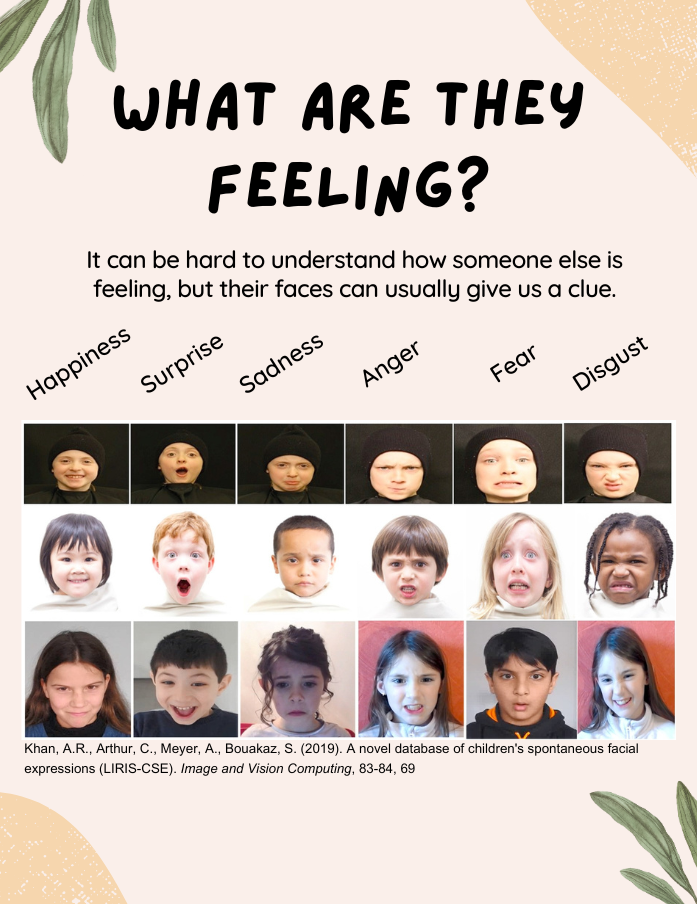We are going to review some social skills described by Dr. Ronald Rapee, who has done a lot of work to help kids be successful in social situations. These include skills related to:
- Body language
- Conversation
- Friendship
- Assertiveness
Body Language:
- Eye contact: Making eye contact with another person while talking with them shows you are interested and paying attention.
- Facial expressions: Facial expressions should match the tone and mood of the topic being discussed. For example, people respond best when their conversation partner smiles when they describe something happy or funny. People who often have bored or angry facial expressions might be seen as unfriendly.
Conversation Skills:
- Starting conversations: Saying “hi” or making introductions is a great way to start a conversation. It can also be helpful to make a comment about the activity people are doing. For example, if a group of people are watching something on their phone at lunch, you might say, “Hi, what are you guys watching?” when there is a break in the video, or you might make a comment about something funny in the video. Or, if you want to talk to someone who is in the same class, you can ask something along the lines of “Hey, have you done the homework yet?”
- Holding conversations: When having conversations, it is important to 1) answer questions while making sure not to say too much or too little, 2) ask questions (especially about what your conversation partner might be interested in), and 3) take turns in a conversation, or have a conversation where both people get to talk about the same amount.
- Topics of conversation: People like talking about things they are interested in. If someone is talking about something they like, they would probably like it if you also made comments about that thing or asked questions about it.
Friendship Skills:
- Offering help or items: Providing help on something like a homework assignment or giving gifts at times like birthdays are great ways to show someone you appreciate them and would like to be their friend.
- Invitations: Inviting others to spend time together or engage in activities together is another great way to build friendships.
- Asking to join in: You may be nervous about asking to join into peers’ activities due to fears of being rejected. This is a great way to face that fear, and when you find the right peers, it often ends up with you having fun!
- Give compliments: People often love hearing compliments. If you like something a friend does or think they are good at something, it is a nice thing to tell them!
- Express empathy: Showing care to others is an important part of friendship. If someone is hurt or expresses feeling angry or some other strong emotion, you may consider asking your friend what is wrong and offering to help.
Assertiveness Skills:
Being assertive means standing up for your rights while respecting the rights of others. It is the happy balance between being passive and being aggressive. People with social anxiety usually fall further on the “passive” side. At other times, anxious people can be aggressive when they feel threatened (the “fight” part of the “fight or flight” response). When you are assertive, people will pay attention to you, which can be very scary if you have social anxiety. For this reason, practicing assertiveness skills can be one of the toughest exposures because it challenges you to stand up for yourself and test out whether you will be judged by others.
- Asking for help: People with social anxiety are often the last ones to ask for help from a teacher, friend, or other trusted adult. If you struggle to ask for help, this is often a great skill to begin practicing at school with a teacher (for example, help with a homework assignment).
- Standing up for yourself: This is one of the most difficult social skills for many people. Sometimes people will not be treated fairly by others. Being assertive in these situations means 1) describing how you feel, and 2) stating calmly what you would like to happen. When practicing this skill, make sure you maintain a tone of respect, as it is easy to become aggressive when standing up for yourself (too loud or expressing anger), which is unlikely to help solve your problems. One tool we teach related to standing up for yourself involves “I feel” statements, which go like this: “I feel _______ when _______. I would like it if _______.” For example, if you are getting left out of a game people play at lunch, you might say “I feel bummed out when you don’t let me play with you guys. I would like it if you gave me a turn.”
- Saying no: You should learn to say “no” when you do not want to do something. If you are doing unreasonable things for others (for example, doing someone else’s homework or letting them cheat off of your assignment), it would be important to practice saying “no.” It may also be helpful to practice how to politely decline peers’ requests for help in certain situations.
- Dealing with teasing or bullying: Teasing is something almost all young people deal with. Because this is so common, everyone needs to find ways to cope with being teased every once in a while. Figuring out a couple lines you can always say (for example, “Wow, this is so boring to talk about”) can help prepare you to respond in these situations. If you are always being teased or bullied, however, it is important to get your school or other adults involved to make sure there are consequences for the bullies.









